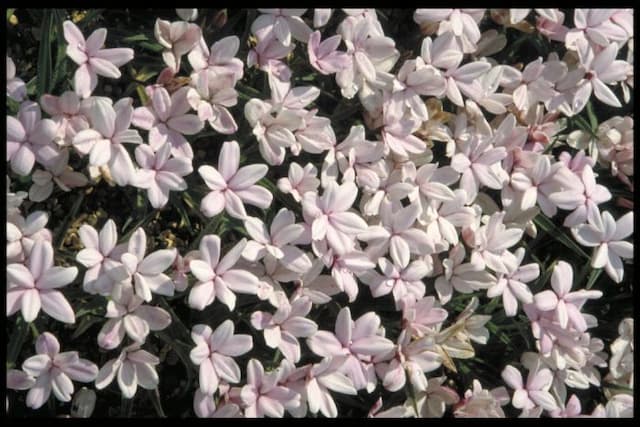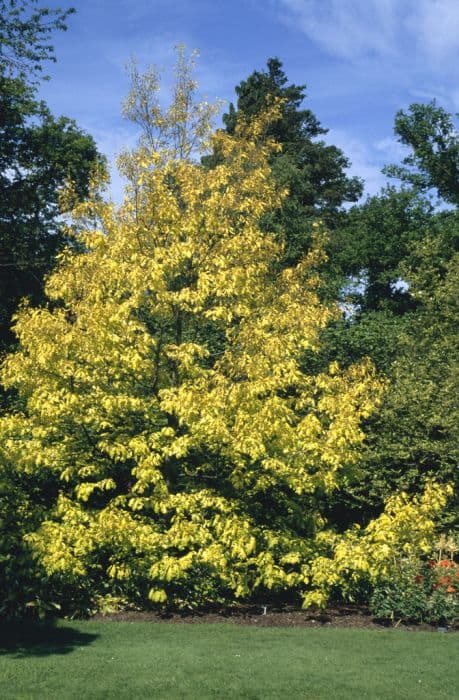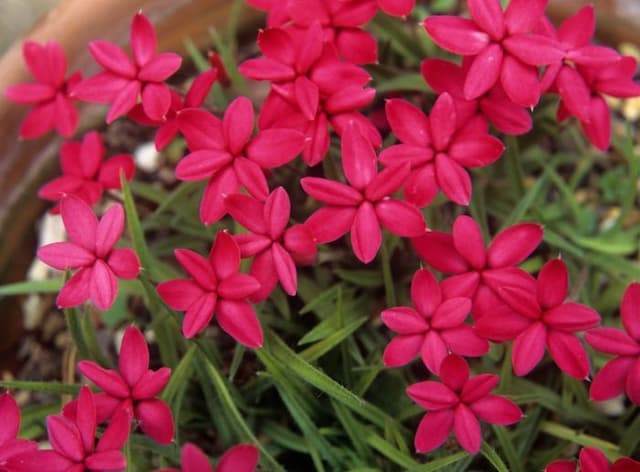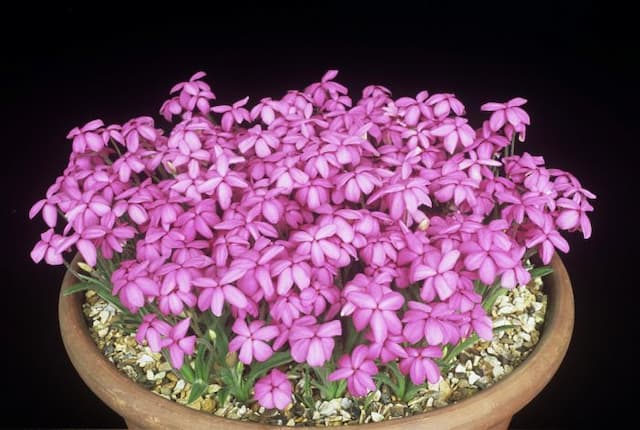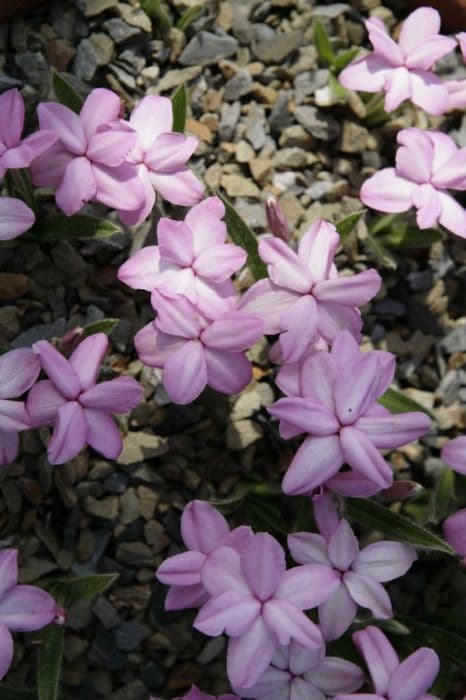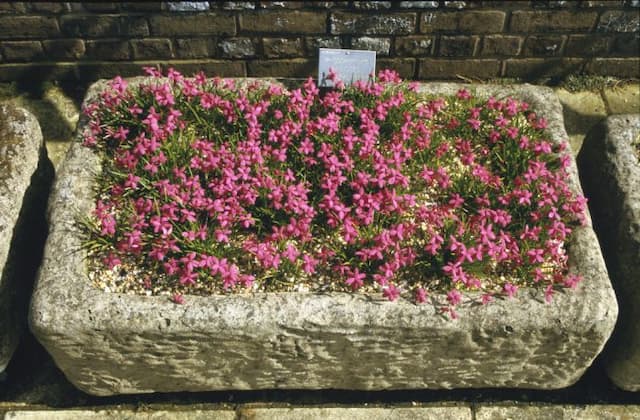Red Star Rhodohypoxis baurii 'Tetra Red'

ABOUT
Rhodohypoxis baurii 'Tetra Red', commonly known as Red Star, is a charming, low-growing perennial that is prized for its vibrant floral display in late spring to summer. The plant has a compact, tufted habit, forming dense clumps of slender, grass-like leaves that are a fresh green in color. Its main attraction is the profusion of star-shaped flowers that cover the plant, creating a lively burst of color. These blossoms are a deep, rich red, which can sometimes seem almost velvety, with each petal having a slightly pointed tip. The flowers emerge from the center of the rosette and can completely engulf the foliage when in full bloom. While in blossom, Red Star provides a brilliant contrast to its own foliage and can add a spot of intensity to rock gardens, alpine displays, or as an edging plant. The visual impact of its intense red flowers can be dramatic and is often used to punctuate areas of the garden with color or attract pollinators such as bees and butterflies. The overall aspect of the Rhodohypoxis baurii 'Tetra Red' is one of a lush, colorful mat that enlivens any space it occupies.
About this plant
 Names
NamesSynonyms
Red Star, Tetra Red Rhodohypoxis, Red Star Grass.
Common names
There are no synonyms for Rhodohypoxis baurii 'Tetra Red'; therefore, the basic scientific name is Rhodohypoxis baurii 'Tetra Red'.
 Toxicity
ToxicityTo humans
Rhodohypoxis baurii, commonly known as Rose Grass or Red Star, is not widely reported to be toxic to humans. There is a lack of substantial evidence or case reports of poisoning from the ingestion of this plant in humans, and it is generally considered non-toxic. Therefore, no specific symptoms of poisoning are associated with Rose Grass. However, it is always advisable to exercise caution and avoid ingesting any part of ornamental plants not intended for consumption.
To pets
Rose Grass is also not widely reported to be toxic to pets. This lack of toxicity means that pets who ingest Rose Grass typically do not show symptoms of poisoning, and the plant is generally considered safe around animals. However, it is important to monitor pets and prevent them from eating plants, as individual animals might have sensitivities, and ingestion of non-food items can cause gastrointestinal upset or other issues. Always consult with a veterinarian if you suspect your pet has ingested a potentially harmful substance.
 Characteristics
CharacteristicsLife cycle
Perennials
Foliage type
Deciduous
Color of leaves
Green
Flower color
Red
Height
3-5 inches (7.5-12.5 cm)
Spread
3-6 inches (7.5-15 cm)
Plant type
Bulb
Hardiness zones
7
Native area
South Africa
Benefits
 General Benefits
General Benefits- Attractive Flowers: Rhodohypoxis baurii 'Tetra Red' offers bright red blooms that add a splash of color to garden spaces.
- Low Maintenance: This plant is quite hardy and requires minimal care once established, making it ideal for busy gardeners.
- Ground Cover: It is a good ground covering plant, which can help suppress weeds and cover bare spots in the garden.
- Drought Tolerant: After establishing a strong root system, it becomes quite drought tolerant, which is beneficial in water-restricted areas.
- Compact Growth: Its small and compact growth habit makes it suitable for planting in rock gardens, borders, or as part of a mixed container display.
- Pollinator Friendly: The flowers attract bees and other pollinators, which are essential for the health of the garden and local ecosystem.
- Seasonal Interest: This perennial plant has a specific flowering season, usually in late spring to summer, providing seasonal interest and variation in the garden.
- Deer Resistance: It is often resistant to deer, making it a good choice for gardens in areas where deer predation is a problem.
 Medical Properties
Medical PropertiesThis plant is not used for medical purposes.
 Air-purifying Qualities
Air-purifying QualitiesThis plant is not specifically known for air purifying qualities.
 Other Uses
Other Uses- Rhodohypoxis baurii 'Tetra Red', also known as Red Star, can be used in miniature gardens due to its small size, which makes it a charming addition to these condensed landscapes.
- In alpine troughs and rockeries, Red Star can create a vibrant ground cover, adding a splash of color among the rocks and other alpine plants.
- Since Red Star is compact and slow-growing, it lends itself well to container compositions, especially when paired with other small perennials or succulents.
- As a photography subject, the vivid red blossoms of the Red Star provide an excellent opportunity for macro photography enthusiasts to capture the detail and texture of the blooms.
- The Red Star plant can be used during festive seasons, especially around Christmas, as part of live table decorations due to its rich red color that complements traditional holiday decor.
- In crafting, the dried flowers of Red Star can be incorporated into pressed flower art, such as creating bookmarks, cards, or framed botanical works.
- This plant can serve as a living gift, symbolizing love or passion because of its red flowers; it's a thoughtful gift for gardeners or plant lovers for occasions like Valentine’s Day.
- Used in a fairy garden setup, the charming Red Star helps to create a whimsical and magical atmosphere with its bright and attractive flowers.
- In bonsai landscapes, Red Star can be a companion plant, adding color at the base of a bonsai tree without competing with the tree's form or size.
- The Red Star can act as a natural dye source, where the petals might be used to dye fabrics or paper with a pale red hue through traditional dyeing techniques.
Interesting Facts
 Feng Shui
Feng ShuiThe Red Star is not used in Feng Shui practice.
 Zodiac Sign Compitability
Zodiac Sign CompitabilityThe Red Star is not used in astrology practice.
 Plant Symbolism
Plant Symbolism- Hope: Rhodohypoxis baurii 'Tetra Red', commonly known as the Red Star, often symbolizes hope due to its bright and star-shaped flowers that seem to shine brightly even in low-light conditions.
- Attraction: The vibrant red color of Red Star's flowers is frequently associated with attraction and charm, making it a plant that symbolically draws people together.
- Endurance: The Red Star is known for its resilience and the ability to withstand various growing conditions, symbolizing endurance and the capacity to thrive against odds.
- New Beginnings: As a plant that emerges from a period of dormancy with vibrant blooms, Red Star is often seen as a symbol of new beginnings or the start of a fresh chapter in life.
- Passion: The Red Star's deep red petals are emblematic of deep passion and intense feelings, making it a plant that represents love and strong emotions.
 Water
WaterRed star plant prefers consistent moisture during its active growth period in spring and summer; water it thoroughly when the top inch of soil feels dry to the touch. Typically, this may mean watering with approximately 8-16 ounces of water every week, but this can vary based on temperature and humidity. It's important to reduce watering in the fall and allow the plant to dry out somewhat as it enters dormancy over winter. Overwintering bulbs should be kept mostly dry to avoid rotting. Provide enough water to keep the soil lightly moist but never waterlogged, as good drainage is essential for the health of the plant.
 Light
LightRed star plant thrives best in full sun to partial shade conditions. Place the plant in a location where it will receive at least 4-6 hours of sunlight daily, ideally in the morning with some afternoon shade to protect it from intense midday sun. An east or west-facing window or a spot in the garden that receives dappled sunlight is suitable for this plant to flourish.
 Temperature
TemperatureRed star plant performs well in a temperature range from 50°F to 75°F, which is ideal for healthy growth. It can withstand temperatures down to around 32°F but should not be exposed to hard freezes. It's important to protect the plant from extreme temperatures both hot and cold as it can be damaged by frost or intense heat above 80°F.
 Pruning
PruningPruning red star plant is mainly about removing spent flowers and dead foliage to encourage new growth and maintain a tidy appearance. The best time to prune is after flowering has ceased, typically in late summer. Pruning too often is not necessary with this plant; once a year post-flowering is generally sufficient. Using clean, sharp scissors or pruning shears, cut the old foliage at the base being careful not to damage new growth buds.
 Cleaning
CleaningAs needed
 Soil
SoilThe Red Star plant thrives in a soil mix consisting of two parts peat, one part loam, and one part sharp sand, creating a well-draining medium. The ideal pH range for Rhodohypoxis baurii 'Tetra Red' is slightly acidic, between 5.5 and 6.5.
 Repotting
RepottingRed Star plants should be repotted every two to three years to refresh the soil and accommodate root growth, ideally in late winter or early spring just before new growth starts.
 Humidity & Misting
Humidity & MistingRed Star plants prefer moderate humidity levels; they do well in typical household humidity but benefit from increased humidity without wetting the foliage.
 Suitable locations
Suitable locationsIndoor
Place in bright indirect light and keep soil moderately moist.
Outdoor
Plant in partial shade with morning sun, protect from harsh elements.
Hardiness zone
7-9 USDA
 Life cycle
Life cycleRhodohypoxis baurii 'Tetra Red', commonly known as Red Star, begins its life cycle as a dormant corm that breaks dormancy in spring. Upon warming temperatures, new shoots emerge, followed by distinctive grass-like leaves. This perennial plant then enters a flowering stage in late spring and early summer, where it displays vibrant red flowers. After the main blooming period, the plant might have sporadic blooms until late summer, depending on the climate and care. Post-bloom, Red Star enters a period of senescence in late summer to autumn as foliage dies back with the onset of colder weather. Finally, the plant goes back into dormancy over winter, with the corm resting underground until the next growing season.
 Propogation
PropogationPropogation time
Spring to summer
Propogation: Rhodohypoxis baurii 'Tetra Red', commonly known as Red Star, is most commonly propagated through division. The best time to propagate is in late winter or early spring just as the plant is coming out of dormancy. Carefully lift the clump from the ground or pot, and gently tease apart the offsets from the main plant. Each division should have at least one growing point or shoot. Replant these divisions promptly into well-draining soil at the same depth they were previously growing. Water the new plantings adequately to encourage root development. This method allows for the rapid increase of plants while maintaining the attributes of the mother plant.
![Rhodoxis [Fairytale]](/_next/image?url=https%3A%2F%2Fplants-admin.emdemapps.com%2Fimages%2Fplants%2F%2Fimages%2F604b54204420d.png&w=640&q=75)

